Blog & Latest Updates
Fly Fishing Articles
Insects by Common Name


Animal Kingdom Animalia (Animals)
Taxonomic Navigation -?-
Kingdom Animalia (Animals)
| Phylum in Animalia | ||
| AnnelidaWorms and Leeches | 0 | 2 |
| ArthropodaArthropods | 0 | 122 |
| ChordataVertebrates | 0 | 4 |
| Mollusca | 0 | 6 |
| PlatyhelminthesFlatworms | 0 | 0 |
Common Name
| Match | Common Name |
| Animals |
This is page 49 of specimens of Animalia. Visit the main Animalia page for:
- The behavior and habitat of Animalia.
- 131 underwater pictures of Animalia.
Pictures of 1264 Animal Specimens:
Cicadidae (Cicadas) Cicada Adult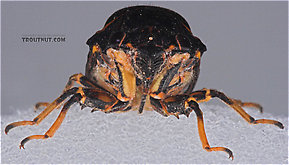 View 4 PicturesI found this cicada and several like it in the grass near my car as I put my waders on. Some of them were singing in the trees above the river, too, but I did not see any fall into the water.
View 4 PicturesI found this cicada and several like it in the grass near my car as I put my waders on. Some of them were singing in the trees above the river, too, but I did not see any fall into the water.
 View 4 PicturesI found this cicada and several like it in the grass near my car as I put my waders on. Some of them were singing in the trees above the river, too, but I did not see any fall into the water.
View 4 PicturesI found this cicada and several like it in the grass near my car as I put my waders on. Some of them were singing in the trees above the river, too, but I did not see any fall into the water.Collected July 1, 2005 from the Bois Brule River in Wisconsin
Added to Troutnut.com by Troutnut on April 22, 2006
Added to Troutnut.com by Troutnut on April 22, 2006
Female Ephemerella excrucians (Pale Morning Dun) Mayfly Dun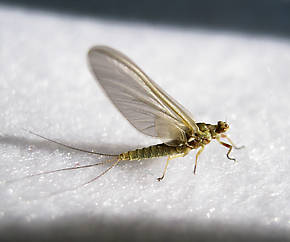 View 3 PicturesSize: 10mm. At emergence the specimen was a fairly bright olive green and there was obvious difference in color between the forewing (med. dun) and the hind-wing (pale cream). It was really noticeable as they floated by. You can just make these features out in the second photo, but not so much in the first that was taken 24 hours after capture. Total time from emergence to molting - approx. 48 hours.
View 3 PicturesSize: 10mm. At emergence the specimen was a fairly bright olive green and there was obvious difference in color between the forewing (med. dun) and the hind-wing (pale cream). It was really noticeable as they floated by. You can just make these features out in the second photo, but not so much in the first that was taken 24 hours after capture. Total time from emergence to molting - approx. 48 hours.
Entoman
Edit 2/25/13 - This specimen was originally posted to E. d. infrequens because of its size. It turns out large size doesn't hold up as a way to tell these two apart. This is because excrucians has much greater variability than previously understood. The assumption by anglers that excrucians is always the smaller of the two is apparently not supported by science. There is a lot left to sort out with western Ephemerella species. This may include new discoveries and/or synonyms (Synonym: A former name of a taxon, usually a species. Entomologists frequently discover that two insects originally described as different species are one in the same, and they drop one of the names. The dropped name is said to be a synonym of the remaining name. These changes take a while to trickle into the common knowledge of anglers; for example, Baetis vagans is now a synonym of Baetis tricaudatus.) as well as reportage on new intraspecific variations broadening the descriptions of recognized species. Based on this specimen's Fall maturity, the best guess is that it is an unusual form of excrucians.
As to color, both species duns (nymphs too) demonstrate a tremendous amount of intraspecific variability from pale yellow to bright green with a multitude of sulfur shadings in between, ranging from pale amber, through orange to cinnamon and even dark brown. I've seen wings from pale cream through tannish and almost every shade of dun except the dark shades. Some have pigment stained leading edges matching their bodies, some don't. Most of these variations are undocumented except in angler references and periodicals. It seems a rare year that a new variation doesn't pop up to the notice of anglers.
Bottom line - size is only reliable if the specimens are smaller than size 16, pointing to excrucians. Otherwise, the only fairly dependable way to tell them apart (especially the females) is by timing as infrequens is the first of the two to appear, rarely lasting longer than a couple of weeks or later than the end of June most years. The problem with using timing for determination is it requires knowledge of the hatch sequences as they actually occurred for a given year on a given piece of water. Obviously, this kind of information is seldom available. Without it, determining between the two duns if they are larger than size 18 is speculative at best - at least until very late in the Summer.
 View 3 PicturesSize: 10mm. At emergence the specimen was a fairly bright olive green and there was obvious difference in color between the forewing (med. dun) and the hind-wing (pale cream). It was really noticeable as they floated by. You can just make these features out in the second photo, but not so much in the first that was taken 24 hours after capture. Total time from emergence to molting - approx. 48 hours.
View 3 PicturesSize: 10mm. At emergence the specimen was a fairly bright olive green and there was obvious difference in color between the forewing (med. dun) and the hind-wing (pale cream). It was really noticeable as they floated by. You can just make these features out in the second photo, but not so much in the first that was taken 24 hours after capture. Total time from emergence to molting - approx. 48 hours.Entoman
Edit 2/25/13 - This specimen was originally posted to E. d. infrequens because of its size. It turns out large size doesn't hold up as a way to tell these two apart. This is because excrucians has much greater variability than previously understood. The assumption by anglers that excrucians is always the smaller of the two is apparently not supported by science. There is a lot left to sort out with western Ephemerella species. This may include new discoveries and/or synonyms (Synonym: A former name of a taxon, usually a species. Entomologists frequently discover that two insects originally described as different species are one in the same, and they drop one of the names. The dropped name is said to be a synonym of the remaining name. These changes take a while to trickle into the common knowledge of anglers; for example, Baetis vagans is now a synonym of Baetis tricaudatus.) as well as reportage on new intraspecific variations broadening the descriptions of recognized species. Based on this specimen's Fall maturity, the best guess is that it is an unusual form of excrucians.
As to color, both species duns (nymphs too) demonstrate a tremendous amount of intraspecific variability from pale yellow to bright green with a multitude of sulfur shadings in between, ranging from pale amber, through orange to cinnamon and even dark brown. I've seen wings from pale cream through tannish and almost every shade of dun except the dark shades. Some have pigment stained leading edges matching their bodies, some don't. Most of these variations are undocumented except in angler references and periodicals. It seems a rare year that a new variation doesn't pop up to the notice of anglers.
Bottom line - size is only reliable if the specimens are smaller than size 16, pointing to excrucians. Otherwise, the only fairly dependable way to tell them apart (especially the females) is by timing as infrequens is the first of the two to appear, rarely lasting longer than a couple of weeks or later than the end of June most years. The problem with using timing for determination is it requires knowledge of the hatch sequences as they actually occurred for a given year on a given piece of water. Obviously, this kind of information is seldom available. Without it, determining between the two duns if they are larger than size 18 is speculative at best - at least until very late in the Summer.
Collected October 16, 2011 from the Fall River in California
Added to Troutnut.com by Entoman on October 21, 2011
Added to Troutnut.com by Entoman on October 21, 2011
Chironomidae (Midges) Midge Larva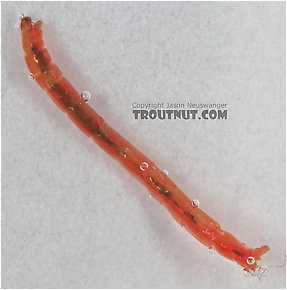 View 2 Pictures
View 2 Pictures
 View 2 Pictures
View 2 PicturesCollected March 13, 2005 from Cascadilla Creek in New York
Added to Troutnut.com by Troutnut on April 5, 2006
Added to Troutnut.com by Troutnut on April 5, 2006
Hydrophilidae (Giant Water Scavenger Beetles) Beetle Adult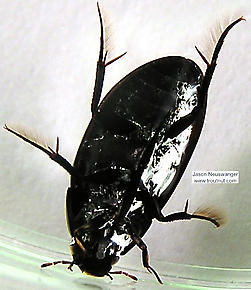 View 2 PicturesThis is a water beetle. It is the hardest object in the world to pick up with tweezers. The second hardest is Mount Everest.
View 2 PicturesThis is a water beetle. It is the hardest object in the world to pick up with tweezers. The second hardest is Mount Everest.
 View 2 PicturesThis is a water beetle. It is the hardest object in the world to pick up with tweezers. The second hardest is Mount Everest.
View 2 PicturesThis is a water beetle. It is the hardest object in the world to pick up with tweezers. The second hardest is Mount Everest.Collected January 13, 2004 from the Namekagon River in Wisconsin
Added to Troutnut.com by Troutnut on January 25, 2006
Added to Troutnut.com by Troutnut on January 25, 2006
Dicosmoecus gilvipes (October Caddis) Caddisfly Nymph View 3 Pictures
View 3 Pictures
 View 3 Pictures
View 3 PicturesCollected October 5, 2010 from the Touchet River in Washington
Added to Troutnut.com by Bnewell on June 27, 2011
Added to Troutnut.com by Bnewell on June 27, 2011
Epeorus grandis Mayfly Nymph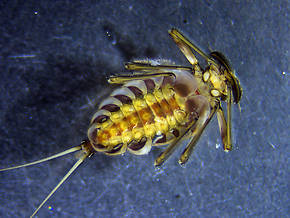 View 3 Pictures
View 3 Pictures
 View 3 Pictures
View 3 PicturesCollected April 8, 2005 from Yellow Bay Creek in Montana
Added to Troutnut.com by Bnewell on June 27, 2011
Added to Troutnut.com by Bnewell on June 27, 2011
Female Eurylophella (Chocolate Duns) Mayfly Spinner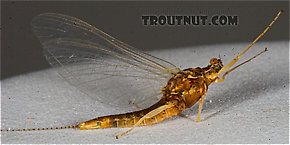 View 4 PicturesI collected this uncooperative specimen as part of a small cloud of female spinners clustered tightly together high about 10 feet above the water, without any males that I could see.
View 4 PicturesI collected this uncooperative specimen as part of a small cloud of female spinners clustered tightly together high about 10 feet above the water, without any males that I could see.
 View 4 PicturesI collected this uncooperative specimen as part of a small cloud of female spinners clustered tightly together high about 10 feet above the water, without any males that I could see.
View 4 PicturesI collected this uncooperative specimen as part of a small cloud of female spinners clustered tightly together high about 10 feet above the water, without any males that I could see.Collected June 21, 2005 from the Namekagon River in Wisconsin
Added to Troutnut.com by Troutnut on May 26, 2006
Added to Troutnut.com by Troutnut on May 26, 2006
Female Baetidae (Blue-Winged Olives) Mayfly Dun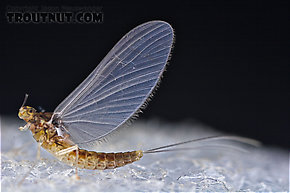 View 5 PicturesI captured this dun on the same night as a spinner which is probably of the same species.
View 5 PicturesI captured this dun on the same night as a spinner which is probably of the same species.
 View 5 PicturesI captured this dun on the same night as a spinner which is probably of the same species.
View 5 PicturesI captured this dun on the same night as a spinner which is probably of the same species.Collected August 9, 2006 from the West Branch of Owego Creek in New York
Added to Troutnut.com by Troutnut on August 11, 2006
Added to Troutnut.com by Troutnut on August 11, 2006
Male Ephemerella subvaria (Hendrickson) Mayfly Dun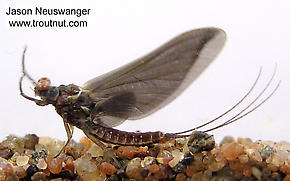 View 3 Pictures
View 3 Pictures
 View 3 Pictures
View 3 PicturesCollected April 14, 2004 from the Namekagon River in Wisconsin
Added to Troutnut.com by Troutnut on January 25, 2006
Added to Troutnut.com by Troutnut on January 25, 2006
Amphipoda (Scuds) Scud Adult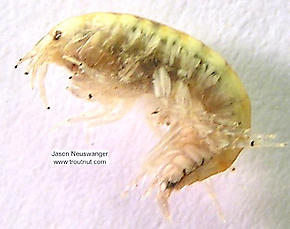 View 2 Pictures
View 2 Pictures
 View 2 Pictures
View 2 PicturesCollected January 13, 2004 from the Namekagon River in Wisconsin
Added to Troutnut.com by Troutnut on January 25, 2006
Added to Troutnut.com by Troutnut on January 25, 2006
Top 10 Fly Hatches
Top Gift Shop Designs
Eat mayflies.
Top Insect Specimens
Miscellaneous Sites
Troutnut.com is copyright © 2004-2024 Jason
Neuswanger (email Jason). See my FAQ for information about use of my images.
 privacy policy
privacy policy
